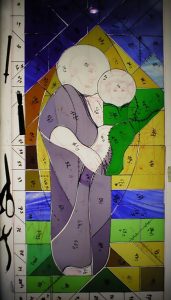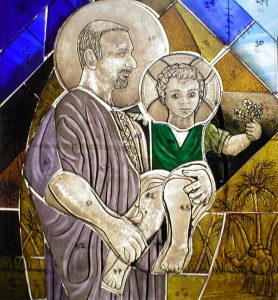Few people understand the amount of work that goes into a good stained glass window. Now that fabricated ‘stained’ glass with stick-on lead and clear acrylic paint features in modern double-glazing the art of the craft is becoming further debased. Real stained glass – as opposed to leaded lights which are just cut pieces of plain coloured glass leaded into a design – is made with the same techniques that medieval stained glass makers used and most of those processes needed to be fired in a kiln.
Stained glass was never cheap – not even in the Middle Ages – because so many people and processes were involved in creating the complex narratives of medieval stained glass. In fact, all of the Cathedral windows were financed by money donated by royalty, noble families and the rich merchant’s guilds of the new cities seeking absolution from their sins in the next world. Without such donations, none of the great medieval Cathedrals would have ever been made.
What follows is a description of the processes involved in even the smallest piece.
- The design is made on a small scale for approval after which coloured glass is selected as to the client or artist’s tastes from sample pieces. Glass can either be cheap machine-made glass or expensive glass known as Antique which is still made in the traditional fashion; i.e. hand-blown and hand-coloured. Antique glass is blown into a circular muff which is then cut down the middle and allowed to flatten in an annealing kiln. This glass always retains varying thickness therefore has unique variations in colour and texture that give it more beauty and interest.

- A full scale ‘cartoon’ in pencil or colour is made to show the pattern, all lead lines of the piece with the width of leads involved and any details in painting and staining.
- The designer makes a cut-line trace from the ‘cartoon’ and it is used as the template for the whole piece.
- The pieces of glass are selected cut to size from flat sheets and are cut according to the cut line then put into context on a light box.
- Processes are then applied to the glass depending on the demands of the design:
• Acid Etching uses Flash glass – glass especially hand-blown with a thin layer of coloured glass flashed onto clear. This layer can be masked out and put in diluted Hydrochloric acid until the colour is gone from the exposed pieces. This process is highly dangerous and needs special facilities.
• Staining uses silver oxide on clear glass then fired in a kiln. The heat transfers colour to the glass and makes a variety of transparent yellows from pale gold to deep amber.
• Painting is done in stages as each element of the design needs firing before it can be worked on again. Glass paint comes in various shades of lead oxides as a fine opaque powder. It can be used thickly as line for painted detail or thinly as a matt – a finely brushed tone applied with a badger brush to shade the coloured glass. Firing to 560°C leads to the surface of the glass becoming melted enough to fuse with the paint for a permanent finish. Matting is used to modify the amount of light coming through the panel. The matt can be scratched into for other effects before firing – in glass of the Middle Ages this was traditionally called grisaille. Illustrative details on glass may need 3 or more firings to build up the levels of tone and texture.
• Enamelling may be done at the next stage where areas of transparent discreet colour can be added to the glass.
• Sandblasting is done last –sand under high pressure is blasted onto the glass surface and makes a frosted white effect that can also be textured and patterned with masking. - Once the initial work has been done the piece is finally put up on a glass easel to make any final adjustments in natural daylight.
- The pieces of glass are leaded together with different widths of lead came. The lead is stretched and cut to fit in sections. At this stage accuracy of cutting is essential. The panel is then soldered, puttied, and cleaned.
- The more processes on a panel of glass the more expensive the piece. Leaded glass without any other work is costed at about £150 per sq. ft. depending on the complexity of the design and the quality of the glass. Painted and stained glass costs considerably more depending on the amount of processes involved.
Some of the decorative glass in this folder is made in Applique – where the pieces are cut and the edges polished before being bonded to clear plate glass using clear epoxy resin. This is good for more complex work and creates a modern look. On toughened glass it is particularly suitable for entrances and hallways.
The Sequence of Creating Stained Glass Panels
[Click image to enlarge]




